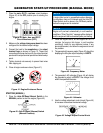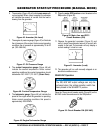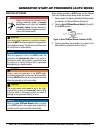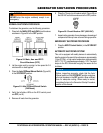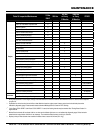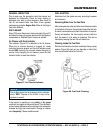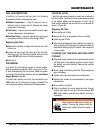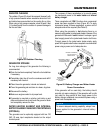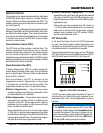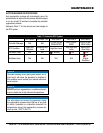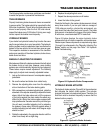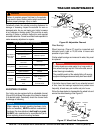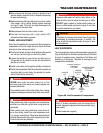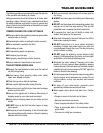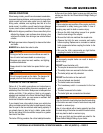
PAGE 44 — DCA70SSJU4i
MAINTENANCE
The emission control system employed with the John Deere
4045HFG93 diesel engine consist of a Diesel Oxidation
Catalyst (DOC) and a Diesel Particulate Filter (DPF). The
oxidation catalyst and particulate filter are housed in one
unit. See Figure 63.
These devices help in filtering out large amounts of harmful
Nitrogen Oxides (NOx) and Particulate Matter (PM) which
are emitted by diesel engines. These exhaust emissions
pose serious environmental and health risks. It is important
to maintain and service this DOC/DPF emission safety
device on a periodic basis.
The DOC does not filter particles it oxidizes them. This
catalyst (honeycomb like structure) uses a chemical
process to break down pollutants in the exhaust stream
into less harmful components. In general this catalyst
collects/burns accumulated particulates. The DOC contains
palladium and platinum which serve as a catalysts to oxidize
hydrocarbons and carbon monoxide.
A diesel particulate filter (DPF) is a device designed to
remove diesel particulate matter (soot) from the exhaust
gas of a diesel engine. This type of filter usually removes
about 85-95% of the soot.
Soot accumulated in the DPF is removed via the
"regeneration process". Regeneration is the process
of removing the accumulated soot from the filter. This
regeneration process can occur in a few different ways.
Passive Regeneration — Occurs during normal
operation, typically under heavy load applications. Soot
is oxidized faster than it is collected.
Active Regeneration — Occurs when engine exhaust
temperatures are not high enough to oxidize the soot
collected in the DPF. Active regeneration requires
assistance from the engine to help increase the heat
level in the after-treatment system.
Active regeneration occurs at a normal engine speed
of 1800 rpm. In addition active regeneration is initiated
automatically by the Engine Control Module (ECM) timer
based program every 96 hours. This timer base program
will reset at the end of any regeneration mode.
— A forced
regeneration only occurs when the operator has initiated
this action at the ECU and the ECM recognizes a pre-
programmed set point of soot in the PDF to allow a forced
regeneration cycle.
This process can take anywhere from 30 minutes to
1-1/2 hours. When forced regeneration is in process all
loads must be removed from the generator, all circuit
breakers must be placed in the OFF position (OPEN),
and the engine speed set to idle.
In the event the Engine Control Unit (ECU) determines
the soot level back pressure and/or temperature has
reached a pre-determined trip point the ECU will indicate
a maintenance action is required by the operator.
This maintenance action will be shown on the LCD display
(DPF Warning Symbol) and the AMBER pre-alarm LED on
the ECU control panel will be ON (lit). See Figure 61.
Figure 61. ECU DPF Pre-Alarm
The DPF pre-alarm status symbol displayed in Figure 61
indicates the soot level buildup has exceeded a pre-
determined level and a "Forced Regeneration" action is
required.
Series 800 Controller
ECU
Engine Started
Shutdown
Pre-Alarm
Alarm
Acknowledge
Screen
Change
Program
Exit
Option
DPF STAT
NOTICE
If the pre-alarm warning LED is ever ON,
the operator should always take immediate action
to correct the problem. If the engine is allowed to run
under this condition, a higher pressure differential will
be created in the DPF and will result in the RED status
LED being ON, causing an engine shutdown.



